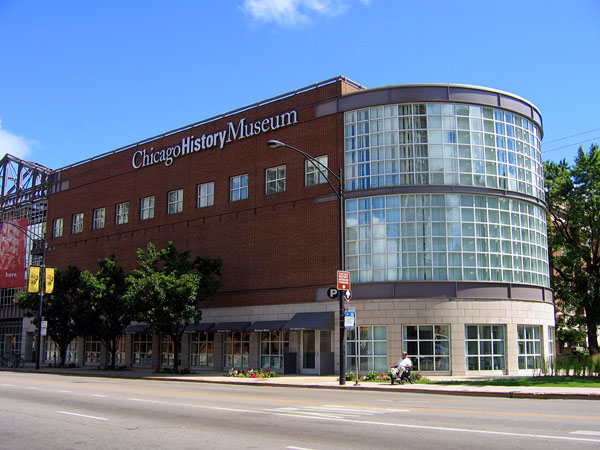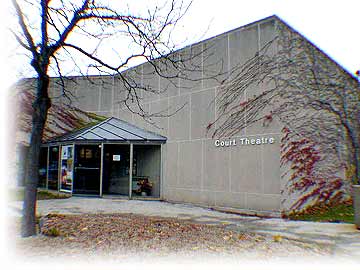You could say I had a magical summer.

Being offered the MAPH internship at the Chicago History Museum had to be a nod to the absolute nerdism of my childhood – I was that kid who dragged her parents to every history museum within reach, wherever we were. I have become that adult who returns to the same ones over and over again. I was a Humanities student, but I am also a lifelong history geek, and the opportunity to intern in the Curatorial Affairs department at CHM let me do exactly what MAPHers do best: bridge the gaps. We’re cross-disciplinarians, proponents of academic cross-pollination.
I studied theater during my MAPH year, venturing out into a little bit of art history and concentrating very much on art-audience communication and relationships. I wrote my thesis on Tony Kushner’s AIDS-era epic play Angels in America, focusing on the work’s ever-changing relationship to its temporal setting: what happens when a play becomes history? I wrestled with Benjamin and his Angel of History, theories on nostalgia, and literature on historical drama. You can see the history geek peeking out. It always has. It’s a necessary marriage, I think.
More on the the internship and how it links to Deborah’s current project after the jump.
When I saw that CHM was on the list of MAPH internships for 2011, needless to say I was pretty thrilled. Museum work wasn’t something I had any experience in, but it was something I had always been curious about, simply by virtue of the fact that I just love museums. MAPH Central encouraged me to think about the similarities between my theater experience and the kinds of work that museum curators do. At the end of the day, we’re asking the same questions: we’re trying to figure out how to help make connections for our audiences, whether it be with a play, brand new or thousands of years old, or with an artifact, whether famous or obscure, manmade or natural. It’s all about telling stories, and telling them in ways that are honest, engaging, and that work for the people who are coming to see them. (It’s no surprise that you’ll sometimes hear the term “curate” in a theater environment, or that museums often employ varying types of theater.) And then of course, the history geek: that connection made it even more perfect. One of the most important things for theater scholars is grappling with how history interacts with and impacts art and culture, and being able to dig into research at a historical institution is an incredible way to explore ways of doing that.

CHM is planning a magic exhibit, and one of our main projects was to work on planning for both the exhibit displays, and its object theater component, thinking about how objects might be considered as “characters,” and why, where, and how potential visitors might connect with potential objects. My officemate (an awesome U of C Metcalf intern) and I taught ourselves magic tricks, pored over books, and watched video footage of the masters to help develop material about how best to tell the story of magic history in Chicago, and in America at large. John Russick, the Director of Curatorial Affairs, a wonderful teacher and a delight to work for, brought us to Chinatown one morning to choose and collect a new artifact, walking us through the acquisition process, and allowing us to see firsthand what kinds of things CHM looks for when it brings a new piece into the collection: in what ways might it speak to visitors? What can it tell them? We did research for exhibition proposals and labeling practices, and worked closely with new acquisitions to the collection, cataloging the ways in which they might make a valuable research tools, all the while grappling with questions that were, as had been my theater work, about the audience’s experience. You, when you sit in that seat or peer through that glass, are an imperative part of that object or that artwork’s value. The immediacy of connection is why we go to these places at all. Without it, we wouldn’t, and the artists and academics and curators who make it all possible are deeply keyed into how best to foster such a complex, but remarkably rewarding relationship.

This fall, I’m assistant directing Court Theatre’s production of An Iliad – a one-man adaptation of Homer’s epic poem. During the first few days of rehearsals, we’ve been talking a lot about the historicity of the piece, and the weight of all it’s seen over its 3,000 years. We’ve begun to think, and will no doubt continue to think over the coming weeks, about where on the continuum the audience can meet our character, the Poet — the storyteller. When I first read the script, my distillation of the piece came down to the idea of storytelling – its necessity, its vitality to our culture, why we are so drawn to it. And this particular story, especially as highlighted in our adaptation, encounters an absolute necessity to be told. There’s a lot to consider about how to build a connection over such a gargantuan period of time. The big question in staging a play is how we are going to draw the audience in – directors, in a way, serve as mediators between the text (as it is manifested through the actors) and the audience, working as the go-between and advocating for the interests of both. Just like a curator. It is, as MAPH always allowed me to ask, all connected.
Deborah Blumenthal (MAPH ’11) completed the MAPH sponsored Chicago History Museum Internship this past summer. She recently started rehearsals as assistant director for An Iliad at Court Theatre. She will be returning there this spring as assistant dramaturg for their production of Angels in America.
Leave a Reply